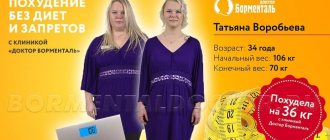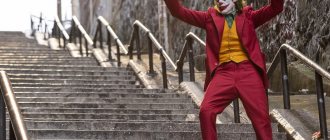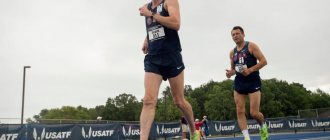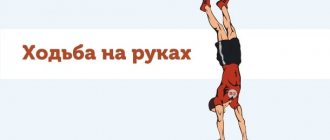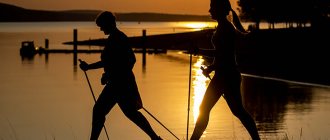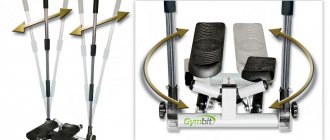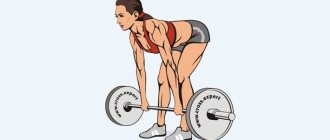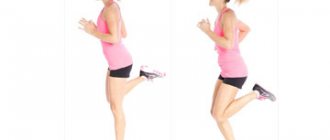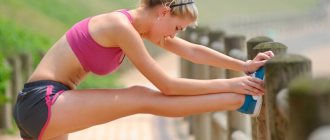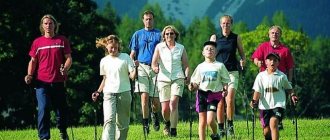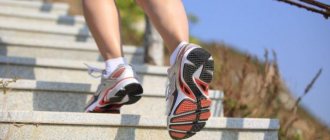The technique of walking with Nordic poles is a fundamental point in health-improving sports methodology. Despite the apparent simplicity of this sport, it is important to strictly follow certain rules in order to achieve the desired effect. Many amateurs, using the technique incorrectly, learn to walk on their own, making numerous mistakes that do not eliminate health problems, but lead to them.
Let's figure out how to walk correctly using the Nordic walking method, accurately select equipment for classes, and how much time to devote to them.
Let's analyze the mechanics of the “northern passage”
The walking technique called “Nordic walking with poles” is based on special mechanics of movements. Thanks to it, you can use almost the entire muscular frame of the body, the total number of which reaches 200 units. Analyzing the movements of Nordic walking, 3 factors are distinguished:
- Physical activity is a closed chain of “events”: a leg – a moving part of the body – an arm fixed on a support;
- 3 joints take part in the movement: pelvis, knee, ankle;
- The skeleton and other joints receive minimal load.
Particular attention is paid to the movement of the legs, which consists of two “stages”: transfer and support. The first stage of “support” is a sequential emphasis on all parts of the foot: heel, midfoot, toe. At this time, putting the other leg forward, the athlete moves to the second point of support. Repeating the support stage, the load “starts” at the heel, then moves to the middle of the foot and toes. The body moves forward, and the other leg is pulled back. This cycle is repeated throughout the entire walking process.
Do you need a warm-up?
Do we need to warm up before getting out of our chairs and walking to the kitchen? Now you have answered the question.
Of course, warm-up movements will never be superfluous. It is always useful to stretch your joints and stretch stiff muscles. Let's put it this way: let it not be a warm-up, but some kind of addition to Nordic walking in the form of exercises. Because standing in the middle of the forest and doing such “exercises” is very useful.
Without fail, this type of activity does not require any preliminary exercises. Of course, if you are planning to run with poles, then you really need to warm up, just like before sprinting.
In the case of a regular walk or workout for weight loss, it will be useful to vary the speed of your steps. It is best to start small, gradually accelerating to 5-7 km per hour or alternating intervals of fast and slow movements.
At first you need to walk slowly, slightly raising the poles with each step. We don’t make any special efforts to support ourselves. After 2-3 minutes we speed up and raise the poles higher. After 10 minutes, you can move your arms to full range. This will be the optimal warm-up.
It is better to do exercises in the middle of walking or after it. We took the sticks, put them together and did squats (a comfortable number of times), body turns, waved our legs, arms, you can even practice fencing (just don’t kill anyone, there are quite sharp metal teeth at the ends of the sticks).
Thus, warming up before Nordic walking is walking itself.
Let's analyze the movements
The Nordic walking technique is based on the usual stepping movement. Therefore, it is necessary to correctly use its main element - the step. To walk with poles correctly, it is important to consolidate the skills into muscle memory. This is done in 3 stages:
- The task is to “feel” the weight of the walking poles. To do this, you need to take them in the middle, and not by the handle. Walk around the room like this, leaning your body forward slightly. Coordinate the involuntary step so that the work of the arm matches the opposite leg.
- We are working on the rhythm. We repeat the movements of the previous stage, changing the position of the sticks: they need to be taken by the “lanyard”. There is no need to push off from the ground; it is enough to “drag” them behind you while simulating Nordic walking. The devices are moved rhythmically, in time with the movements of the hands.
- Directly Nordic walking, which uses poles. By this point, moving your arms and legs should become familiar, so pushing off the ground with the help of devices will make it easier. At this time, the last stage of synchronization is being worked out: a simultaneous push of the heel and the stick in the opposite hand.
The instructions for the Nordic walking technique with poles imply compliance with the following rules:
- Support devices are used by holding them only at an angle;
- You cannot place your body weight on the entire foot at once: it is important to “roll” it from heel to toe;
- When taking a step, your legs bend slightly at the knees;
- The arms are slightly bent, moving up and down;
- Walking is carried out only with a straight back;
- Do not put too much pressure on the devices: this will increase the load on the bones and joints;
- The shoulders relax and drop down a little;
- When the hand is pulled back, the hand is completely unclenched: the stick is held only by a special glove;
- When moving back and forth, your arms should be within forty-five degrees of your body.
Once the basics of the technique have been mastered, you can use walking by confidently increasing the pace of movement: increasing the amplitude of your arm swings, making your steps wider.
Nordic walking lessons for beginners include 3 techniques:
- Fast pace of “triple” steps;
- Wide step;
- Parallel movement of arms and legs (sliding of the left leg while leaning on the left stick).
The “introduction” of each technique into technique training occurs gradually, as walking skills progress, in order to increase the load.
How to choose suitable poles?
Not every beginner is able to choose the right poles. Meanwhile, it depends on whether the classes will be enjoyable and useful. The main thing to keep in mind is that ski poles are not suitable here. You need poles with replaceable tips (sharp ones for walking on slippery or loose surfaces).
With ergonomic, non-slip handles and a tight-fitting, wide lanyard (loop tape).
The height of the poles is calculated as follows: your height in centimeters must be multiplied by 0.68. For example, if you are 170 cm tall, the height of the pole that will fit you perfectly will be 170 x 0.68 = 115.6 cm.
However, there are universal poles that can be adjusted to suit your height. And you can order such good quality Scandinavian poles using the link.
Here is their brief description:
- 3-section adjustable telescopic pole. Height adjustment for any height.
- Cork handle, very comfortable to hold and anti-sweat.
- Anti-shock spring mechanism reduces stress on hands and wrists.
- Durable and adjustable wrist straps provide a safer, more secure grip
- Manganese steel tip with removable rubber tip.
Based on my own experience of finding suitable poles in sports stores, I will say that this is not easy for a beginner. As a result, you can only spend money, but not get the right product. In addition, usually, in online stores, goods of the same quality will cost less.
Here we have selected suitable Scandinavian poles in two price categories that you will be pleased with. Scandinavian poles (aluminum alloy) and ultra-light poles (carbon fiber) with a luxurious lanyard, but more expensive.
Unjustified savings
By the way, one of my friends, a beginner “Scandinavian-style walker,” made the same mistake! She read about the benefits of such activities, watched videos, master classes by trainers, and studied the instructions. Then I decided to start immediately.
She didn’t want to order poles specially for herself, wait for delivery, or spend extra money. Her son’s ski poles were gathering dust on her balcony, so she decided to take them for herself! In the end, nothing good came of it. After classes, the woman’s back hurt and her legs were tense.
Later, she joined the training group, and the coach explained her mistake. She ordered new poles and adjusted their height correctly. And now he gets both pleasure and benefit from Nordic walking!
Finnish walking master class
I suggest watching a video master class on Nordic walking:
That's all we wanted to tell you about Nordic walking for beginners. Don’t be lazy, master this new technique for yourself. On your own or with the help of a qualified trainer. This is the path to your personal freedom, health, well-being and energy. And it doesn’t matter how old you are! I also recommend a useful article about my personal experience of Nordic walking at the link.
Of course, physical activity is of great importance, but have you tried brain fitness? Follow the link and try it!
See you again! Don't forget to subscribe to this blog! We still have a lot of valuable, useful materials ahead, about Nordic walking and more. Share materials with your friends on social networks, they will probably also be interested.
Correct breathing
Any physical activity is performed using breathing techniques. Breathing also plays an important role during Nordic walking. However, in this case there are no strict regulations and rules. When walking with poles, inhale through the nose, exhale through the mouth.
To understand how to breathe correctly when Nordic walking, you need to forget about all the rules, relying on the natural functions of the body. Natural breathing is the main condition for walking in the fresh air in the Scandinavian way.
Note!
In order not to “knock down” your breathing, we follow this rule: inhale and take 2 steps, exhale – 3.4.
Conversations, singing or reading poetry while moving are used as breathing exercises. With their help, blood flow improves, which helps tissues and organs be better saturated with oxygen, subcutaneous fat quickly “leaves”, and endurance appears.
Video about Nordic walking
Lecture by Kristina Volodina - sports medicine doctor, teacher of the Department of Sports Medicine and Rehabilitation of Moscow State Medical University named after. I.M. Sechenov.
In the lecture:
- What is Nordic walking, how is it useful?
- Preparing the reserve of the cardiovascular system using Nordic walking;
- Using Nordic poles to prepare for a marathon, triathlon or mountain climbing;
- The difference between Scandinavian poles and ski and trekking poles;
- Why is it important to monitor your pulse zones and how Nordic walking can help with this;
- Basic Scandinavian step technique;
- Examples of exercises for developing strength and coordination with Nordic poles.
Preparation for training and its completion
An important condition for obtaining the healing effect of moving in the Scandinavian way is the use of a warm-up.
We list the exercises that are used at home. They are needed to warm up the muscles before training. Their task is to use the entire muscular framework of the body, which must work constantly.
- The stick acts as a projectile. She is lifted above her head. Slowly bend to the right, then to the left. Do 8-10 times in each direction.
- Put the stick aside. Take a shallow lunge with your right foot. Lean forward while pointing your arms back. Then change your body position: point your arms forward and tilt your body back. After completing the exercise 10-15 times, change your leg on the lunge and repeat it another 10-15 times.
- Take sticks. Place them so that your arms are slightly back. Leaning on them, do squats. Their number depends on the level of training of the novice athlete and varies from 3 to 15 squats.
- Lean on the walking aid with your right hand. With your left hand, grab your left knee. Standing on one right leg, carefully try to bring your left leg, bent at the knee, closer to your buttocks. Stay in the achieved position for 10-15 seconds. Change the supporting leg and arm and repeat the exercise. Do 8-10 times.
- Slowly, without jerking, we raise our arms with support up, slightly spreading them to the sides 8-10 times.
- We place both sticks in front of us at a distance of straight arms. We bend forward, arching our back. Repeat 8-10 times.
- With your right hand, take one end of the device and place it behind your back. With your left hand, grab the lower end of the stick in the area of your lower back and hips. Slowly raise your right arm up until muscle tension reaches its maximum. Do 8-10 times with each hand.
Many Nordic walking enthusiasts ask whether they can supplement their workouts with their own exercises. The answer is definitely yes. Moreover, after long exercises, a person can choose exercises for warming up, because the needs of each “athlete” for warming up the muscles are different.
Important!
After warming up, lovers of Nordic walking should check the poles and fastenings on them, and adjust the length of the straps.
After completing the training process, it is recommended to do exercises aimed at stretching the muscular frame of the back, hips and shoulder girdle. All movements after training are performed at a “relaxation” pace, slowly. Bathhouse. A sauna or a hot bath filled with aromatic oils - all these water procedures will allow your muscles to relax and reduce pain after exercise to a minimum.
History of origin
The history of the emergence and development of Nordic walking is connected with Finnish skiers. Back in the middle of the last century, they used ski poles to keep fit in the off-season. In the summer, Finnish athletes ran cross-country trails using poles.
Later, the experience of Finnish skiers was picked up by athletes from other European countries and the USA. And not just skiers.
American runner Tom Ratlin, after receiving a serious injury, began using ski poles for training. This is how two sports merged, and a new direction emerged.
In 1997, the first specialized walking poles were released in Finland. They are shorter than ski ones and have other design differences.
In 2000, the International Nordic Walking Association (INWA) was founded, with headquarters in Finland. Currently, the Association includes more than 20 countries, including Russia.
Selection of devices
Since the main “assistant” in Finnish walking is sticks, for the effectiveness of training, their correct selection is as important as the technique of movements.
The first special devices were released in 1997.
Their length is an important selection parameter. It is selected individually. To choose the right poles that are comfortable to hold, simple calculations are carried out. The height of a beginning “athlete” is multiplied by a certain coefficient:
- 0.66 – during recreational activities;
- 0.68 – for fitness training;
- 0.7 – for “serious” sports activities.
Since all devices have standard sizes differing by 5 centimeters, the result obtained is checked against the table and the appropriate option is selected. If the number is in the interval between the presented size values, the choice is made based on the person’s physical fitness. For example, if he has just started “sports activity” or has limitations due to illness, choose a lower value. For a trained person, you can choose higher equipment, since in this case the load on the spine increases.
Note!
The best option for beginners are telescopic poles. Their size changes during training. In addition, 1 pair can be used by all family members.
When choosing devices, pay attention to the material from which they are made. Carbon is reliable, strong and expensive. Aluminum is lighter and cheaper. Any kit is not cheap, so you need to choose it responsibly.
Kinds
We studied what race walking is and how to walk correctly, but did not consider its varieties. Let's list them briefly:
- Slow pace - speed is approximately 80 steps per minute;
- Medium - 120 steps per minute;
- Sports - 150 steps per minute. At this speed, 1 kilometer travels in 7 minutes. This is the pace that is considered ideal for participating in long-distance competitions;
- Fast pace - it is practiced only by experienced athletes, their average speed reaches 10-16 km/h.
Duration of training
An important rule of Nordic walking is adherence to the training regimen and proper distribution of the load.
How long to walk in Scandinavian style is determined individually. This parameter consists of the athlete’s physical fitness, the presence or absence of diseases and the “experience” of training. Average information, which recommends training for 40 minutes three times a week, cannot be taken into account: in each specific case the “dosage” of training will be different.
Nordic walking for weight loss
Nordic walking can be used as an auxiliary exercise for weight loss. But you shouldn’t hope that this will be a magic wand and the weight will go down. The main principle of losing weight is calorie deficit.
Nordic walking will help you burn a little more calories and strengthen your muscles, heart and blood vessels. An hour of active walking can burn up to 500 kcal, no more. These are 2 small burgers or a chocolate bar with nuts. By “treating” yourself to a chocolate after a workout, you will regain the calories you spent while walking, and the weight will not shift. You can only lose weight if you consume less than you spend.
Some rookie mistakes
Many lovers of sports movement try to start training on their own, without joining Nordic walking clubs. This approach will significantly save your finances, however, without an experienced mentor, classes will not be effective.
Let us list the main problems of novice athletes:
- Poor quality or incorrectly selected poles quickly become deformed after a few training sessions;
- If the position of the hands is incorrect, the sticks “take” the wrong position, moving backward;
- Pressing the stick with a brush leads to rapid fatigue with minimal energy expenditure;
- Uneven and improper load on the feet leads to the appearance of corns and rough skin;
- Incorrectly selected or low-quality shoes will lead to rapid foot fatigue.
Nordic walking is a useful sport that brings health improvement and a sea of positive emotions. It can be practiced in winter and summer, autumn and spring. Team training will help you find new friends, prevent depression from developing, and maintain excellent mood and well-being for a long time.
Nordic walking competition
With its growing popularity, Nordic walking has become a separate sport. There are federations, associations and other Nordic walking organizations in many countries around the world. Cups, marathons, tournaments and Nordic walking festivals are held. For a calendar of major events in Russia, see the website of the Russian Nordic Walking Federation .
Play sports, move and travel! If you find a mistake or want to discuss the article, write in the comments.
Subscribe to us on Telegram , YandexZen , VKontakte and Facebook
